Late Collisions
Introduction
Again, we
are going to make use of a step-by-step example in
order to fully understand how and why late
collisions occur.
Late Collisions
Late
collisions, on the other hand, are not normal and
are usually the result of out of spec. cabling or a
malfunctioning adapter. A late collision is defined
as any collision that occurs after 512 bits of the
frame have been transmitted. The rationale behind
this is discussed in the next essay.
In this
discussion we will refer to the same network
described in the discussion of early collisions, but
with one modification: In this network, the network
administrator has violated the maximum cable length
(500 meters for 10BASE5 thick ethernet, 185 meters
for 10BASE2 thin ethernet) by either adding too many
repeaters in between Stations A and B or by laying
too much wire between them.
The
following is an outline of a late collision event
caused by out of spec. cabling:
Station
A, detecting that the wire has been idle for 9.6
microseconds, begins to transmit its data frame,
beginning with the 64 bit preamble. Station A
transmits 256 bits of its frame. If the cabling were
in spec and Station B began to transmit, causing a
collision, even if Stations A and B were on the
farthest ends of the wire from each other the
collision would be detected by station A before it
could transmit its 512th bit. (Stage 1)
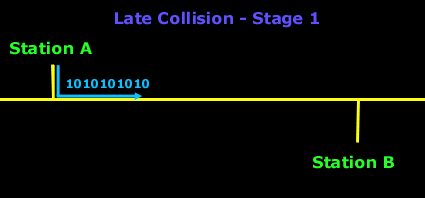
Station A
continues to transmit bits, and meanwhile, down at
the other end of the wire, just before the
electrical signal reaches Station B, Station B
detects idle wire for 9.6 microseconds and begins to
transmit. (Stage 2)
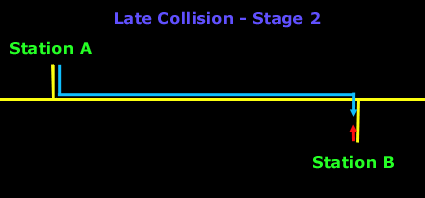
A minute
amount of time later, a collision occurs. (Stage 3)
Station B, being extremely close to the collision,
detects it first and begins transmitting a 32 bit
jam signal.
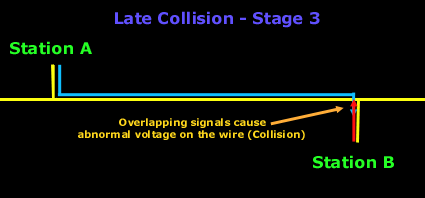
The
collision begins to propagate down the wire towards
Station A (Stage 4), followed by the 32 Bit Jam
signal generated from Station B.
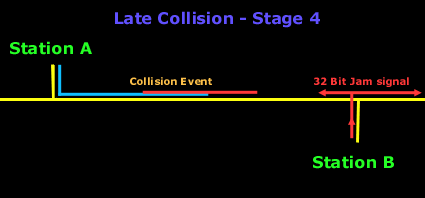
But
because the cabling was out of spec. by the time it
gets to Station A, Station A has already finished
transmitting and is no longer listening for
collisions! (Stage 5) Station A is completely
unaware that a collision has occurred!
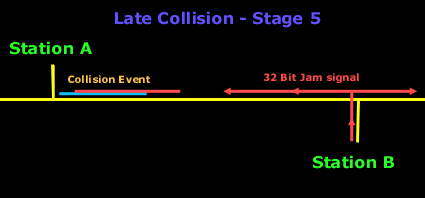
The
reason that late collisions are a problem is that
once the NIC misses the fact that a collision has
occurred, recovery and retransmission are left to
the upper layers and recovery time goes up
drastically. While a NIC will typically recover and
retransmit a frame in 2-3 milliseconds, it typically
takes anywhere from 10 to 100 times that long for
upper layers.
The
other major cause of late collisions is a
malfunctioning NIC. If a NIC malfunctions in such a
manner that it is unable to detect that another
station is talking, late (and early) collisions will
occur. |
